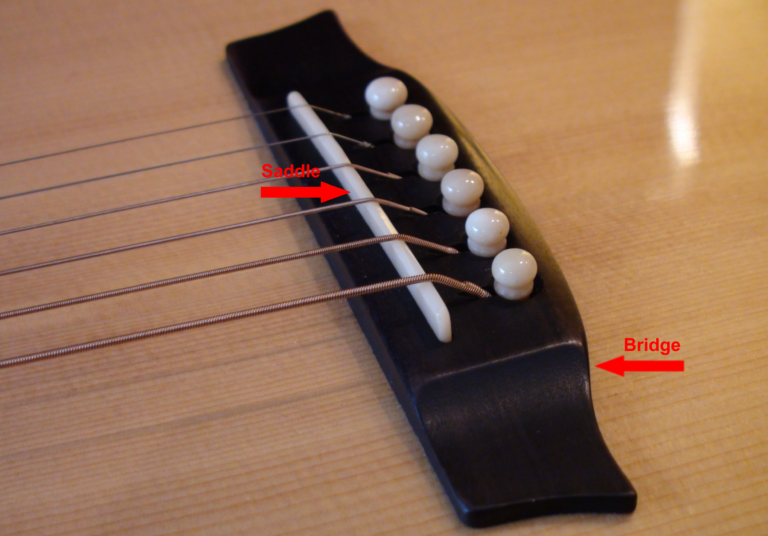Acoustic Guitar Bridge Versus Saddle
Are you wondering about the difference between an acoustic guitar bridge versus the saddle? People often use the two terms interchangeably, but they are distinct parts. The bridge is the wooden piece that holds the saddle and bridge pins in place on the guitar top. However, the saddle is the thin piece of plastic or bone upon which the strings rest. Read on to learn more about these parts.

Acoustic Guitar Bridge
Typically made of rosewood or ebony, an acoustic guitar bridge has one long slot for the saddle as well as six holes for each string. The bridge’s primary purpose is to hold the saddle and strings in place. It also transfers string energy to the guitar’s top. Unlike top material, which is typically made of softer woods, such as Sitka spruce or cedar, luthiers make bridges from dense hardwoods for better energy transfer to the top.
Acoustic Guitar Saddle
Often called the ‘bridge saddle,’ the saddle is the thin, long piece of plastic or bone that the strings rest on. Saddles typically run around 70 to 75 mm long with a thickness of either 2.5 mm (3/32 inch) or 3.2 mm (1/8 inch). Saddle height varies for each individual guitar, even from the factory. Each guitar will have a slightly different neck angle. As such, although the factory might set the action at a specified height, they can achieve this through a combination of adjusting the neck relief, nut slot height, or saddle height. As a result, replacement saddles often come in taller heights and can then be adjusted for the specific guitar.
Guitar Saddle Radius
Saddles typically come with a top radius that matches the guitar’s fretboard radius for improved playability. Common neck and saddle radii for acoustic steel string guitars are 12, 15, and 16 inches, with 10, 14, and 20 inches also used.
Compensation Pattern
Saddles often come compensated for the different string gauges. However, uncompensated, or straight, saddles appear on guitars, too. Numerous acoustic guitar saddle compensation patterns exist.
